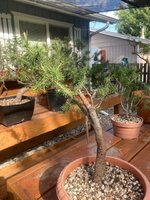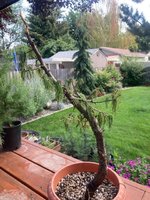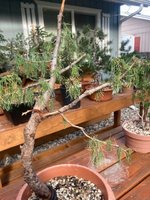I am having frustrating issues with collected Western Larch this year. It all started this spring when they were left out over night with new growth/needles and it go down to 25F or so. Most of the needles turned a creamy white. The trees tried to re-grow needles and in most cases they did somewhat do that so we had green and white needles on the trees together. Some of the trees never got green needles and they just faded away. The trees left have been struggling all summer for the most part. They have been under 50% shade cloth and watered well. Weather 80-95 degrees for several weeks here. Last weekend I did a little fertilizer routine with Bonsai Pro 7-9-5 @ 1/4 TSP/gal and Alaska Fish Fertilizer 5-1-1 @ recommended dose. Next morning everything was good except two larches...the needles had just collapsed and looks like they will all fall off soon as they are loosing them now at fairly high rates. The rest of the larches on the same bench were fine. First picture is Larch doing ok. Next 3 are of one of the two larches that crashed. Obviously the two that crashed are in shade now. Thoughts appreciated.
You are using an out of date browser. It may not display this or other websites correctly.
You should upgrade or use an alternative browser.
You should upgrade or use an alternative browser.
LARCH WRECK...INPUT NEEDED PLS
- Thread starter August44
- Start date
Eckhoffw
Masterpiece
Damn. Wish I could help
Good luck!
Good luck!
Wires_Guy_wires
Imperial Masterpiece
High amounts of organic nutrients can make bacteria flourish. They excrete co2 and acids and that kills the roots.
You can probably smell the difference between a healthy pot and the ones your dying trees are in.
Try to fill the pots to just below the rim too. This helps form a water column that draws in air.
You can probably smell the difference between a healthy pot and the ones your dying trees are in.
Try to fill the pots to just below the rim too. This helps form a water column that draws in air.
WNC Bonsai
Omono
I have had this happen too and pretty much the same situation. Late spring frost them total collapse in August. I think the trees just can’t take the spring stress followed by the late summer heat stress. I have 10 American larch that have survived here for over 5 years now but I have killed 14 of 30 Japanese larch as a result of this same set of conditions—you’d think I would have learned by now! Some types of larch just don’t take late spring frosts as well as others. I now baby them and move them to part shade in July-August. For a while I thought it was the instant larch death they are seeing in the UK but it doesn’t fit those symptoms, other then death. At any rate once the needles on the whole tree collapse I have never had them recover.
GGB
Masterpiece
I've seen that happen to quite a few native larch bonsai near me. I was told it was heat stress that destroyed roots the year before. I don't know if it's true or not but it was enough for me to quit larch
Deep Sea Diver
Masterpiece
Very sorry to see this August.
It sure looks like the fertilization put just enough osmotic stress on the roots to short the tender needles of water.
regards
DSD sends
It sure looks like the fertilization put just enough osmotic stress on the roots to short the tender needles of water.
regards
DSD sends
Hmmm...don't know what osmotic stress is. As I said above, a bunch of my Larches got frost burned early in the spring and have been struggling since. I don't think this would have happened if the spring burn wouldn't have happened to begin with. I see wild larch get frost bit at the apex up in the forests all the time in the spring, but they just re-grow the needles and take off again. I will keep larch in mulch on the North side of the house out of the wind maybe.Very sorry to see this August.
It sure looks like the fertilization put just enough osmotic stress on the roots to short the tender needles of water.
regards
DSD sends
andrewiles
Shohin
Nope, different kind of larch.
I'm no expert but here's my take based on what I've seen with my collected larches. If the tree that collapsed has not yet formed terminal buds it is probably a goner. Just not enough time in the season to get another flush and bud set even if it has the energy.
If it does have buds then I think your best bet is to focus on getting it through the winter to next spring, and then treat it as you would a newly collected tree with minimal roots (shade, mist, etc.). That would mean focusing on fall dormancy right now, not trying to trigger new growth. I recall fall dormancy for larches is based on reduced photoperiod so an extreme appraoch would be to move it to a dark space for a month or so. Around here the leaf drop trigger is in September.
But yeah, I'm no expert...
I'm no expert but here's my take based on what I've seen with my collected larches. If the tree that collapsed has not yet formed terminal buds it is probably a goner. Just not enough time in the season to get another flush and bud set even if it has the energy.
If it does have buds then I think your best bet is to focus on getting it through the winter to next spring, and then treat it as you would a newly collected tree with minimal roots (shade, mist, etc.). That would mean focusing on fall dormancy right now, not trying to trigger new growth. I recall fall dormancy for larches is based on reduced photoperiod so an extreme appraoch would be to move it to a dark space for a month or so. Around here the leaf drop trigger is in September.
But yeah, I'm no expert...
Deep Sea Diver
Masterpiece
Basically osmotic stress occurs when a high concentration of ’salts’ is outside the root cells, lowering the concentration of water there. The roots cells contain a higher concentration of water. When the difference between the root cells and outside is becomes too great, the water in the roots flows outside to try to compensate the water inbalance.Hmmm...don't know what osmotic stress is.
This phenomenon weakens or interrupts the water flow up the tree. The needles are furthest from the roots, so these are affected first… causing the needles to wilt.
This is the main reason folks are told to water soon before fertilizing. This hydrates the area around the roots so when fertilizer arrives there will be less of a difference between the concentration of water inside the root cells and outside.
Another time this situation frequently occurs is when one fertilizes a tree in the weeks after major root work.
Highly likely. Its also highly likely the roots were frozen and damaged. This would explain why the tree was not robust afterwards..As I said above, a bunch of my Larches got frost burned early in the spring and have been struggling since. I don't think this would have happened if the spring burn wouldn't have happened to begin with.
In this case the roots are insulated by the ground. Only the needles are affected. Thus the tree has working roots, so the energy stored in the tree is able to be used to activate new buds.. I see wild larch get frost bit at the apex up in the forests all the time in the spring, but they just re-grow the needles and take off again.
It’s Western Larch. Larix occidentalisIs this the same larch we have out here (larix laricina)?
Very likely ….unless the roots could uptake enough water to make the needles turgid soon. Misting may help.I'm no expert but here's my take based on what I've seen with my collected larches. If the tree that collapsed has not yet formed terminal buds it is probably a goner.
Both photoperiod and temperature are triggers. Yet it takes a number of weeks/months to achieve full dormancy.If it does have buds then I think your best bet is to focus on getting it through the winter to next spring, and then treat it as you would a newly collected tree with minimal roots (shade, mist, etc.). That would mean focusing on fall dormancy right now, not trying to trigger new growth. I recall fall dormancy for larches is based on reduced photoperiod so an extreme appraoch would be to move it to a dark space for a month or so. Around here the leaf drop trigger is in September.
None of us are, we are all learners.But yeah, I'm no expert...
cheers
DSD sends
Knightlife
Seedling
A larch can also be killed with too much love… I overwatered one larch once and it died. ;( When the stem swells it’s a sure sign. Maybe that’s what’s happening?
I learned the hard way that Larch are way more sensitive than I thought. The winter in the cold frame, the early growth/bud popping, then out on the bench in good weather, then a 25 degree F freeze one night, then needle turning white, and then the struggling all spring and summer is how it went. The few larch that were in top shape, are coming out of it. The rest DOA. There are millions more in my mountains. Live and learn!
Eckhoffw
Masterpiece
Right there with you man! Live and learn, and prepared to “learn” a great deal more.I learned the hard way that Larch are way more sensitive than I thought. The winter in the cold frame, the early growth/bud popping, then out on the bench in good weather, then a 25 degree F freeze one night, then needle turning white, and then the struggling all spring and summer is how it went. The few larch that were in top shape, are coming out of it. The rest DOA. There are millions more in my mountains. Live and learn!
PonderingSage:
Shohin
Well… the benches look good!
Paradox
Imperial Masterpiece
Yea once the buds open, I don't like to let mine go below freezing.
Actually, they are a little bare now between loosing most of the spruce to fungas, and the larch to freezing early, and then rethinking a lot of other trees that I had accumulated. Going to start over again. See you this fall.Well… the benches look good!
sorce
Nonsense Rascal
When were they collected and what was their action last year?
I fear the "cold frame".
Unnatural happenings (pruning, collection, etc) and unnatural Winter conditions is the only way a tree will "wake up early", "waking up early" is what killed them, not the frost or anything else...(unless....)
The first tell of a pressure change comes on the wind, if they can't feel that they can't adjust.
Overprotection is a larger killer than winter, sure, some folks have many trees that survive it just fine, but there's a lot of information omitted from these stories, information you need to gauge how similar your other 43 practices are.
My story is simple. Since I've been just setting them on the ground huddled within 30ft of where they've been and stopped "repotting as the buds swell", I've never lost a tree with winter as a part of it. Never lost a tree to winter alone. Ever.
Not even the -28F year.
Never lost a tree to summer repotting either.
Less work more pleasure.
Sorce
The winter in the cold frame, the early growth/bud popping, then out on the bench in good weather, then a 25 degree F freeze one night
I fear the "cold frame".
Unnatural happenings (pruning, collection, etc) and unnatural Winter conditions is the only way a tree will "wake up early", "waking up early" is what killed them, not the frost or anything else...(unless....)
The first tell of a pressure change comes on the wind, if they can't feel that they can't adjust.
Overprotection is a larger killer than winter, sure, some folks have many trees that survive it just fine, but there's a lot of information omitted from these stories, information you need to gauge how similar your other 43 practices are.
My story is simple. Since I've been just setting them on the ground huddled within 30ft of where they've been and stopped "repotting as the buds swell", I've never lost a tree with winter as a part of it. Never lost a tree to winter alone. Ever.
Not even the -28F year.
Never lost a tree to summer repotting either.
Less work more pleasure.
Sorce
PonderingSage:
Shohin
August,
we had a variable spring as well.
I definitely did some tree juggling after some things pushed early
we had a variable spring as well.
I definitely did some tree juggling after some things pushed early
Yes, you are correct...it was pretty weird. I had forgotten that.August,
we had a variable spring as well.
I definitely did some tree juggling after some things pushed early
Similar threads
- Replies
- 9
- Views
- 303
- Replies
- 3
- Views
- 247
- Replies
- 4
- Views
- 174




